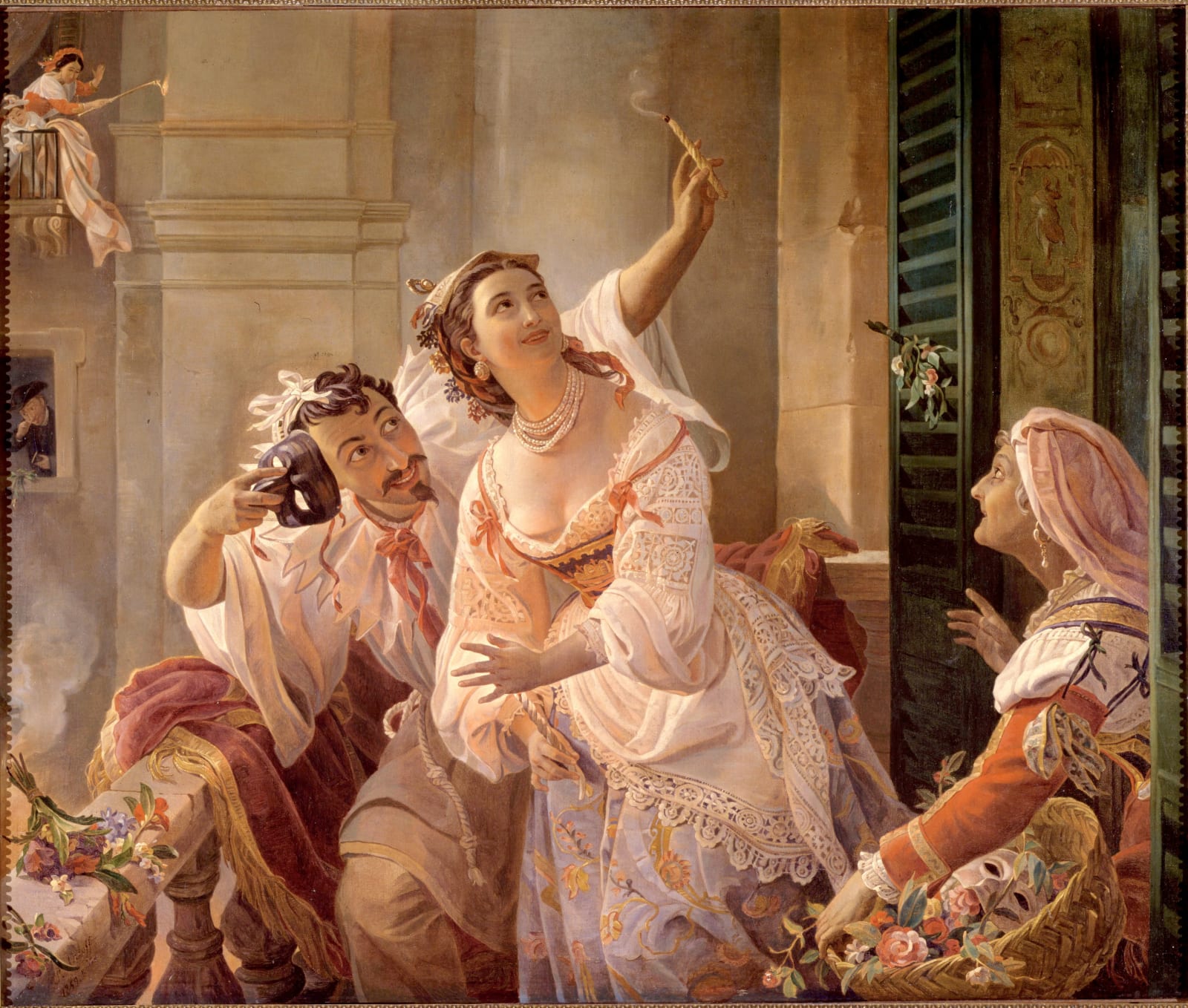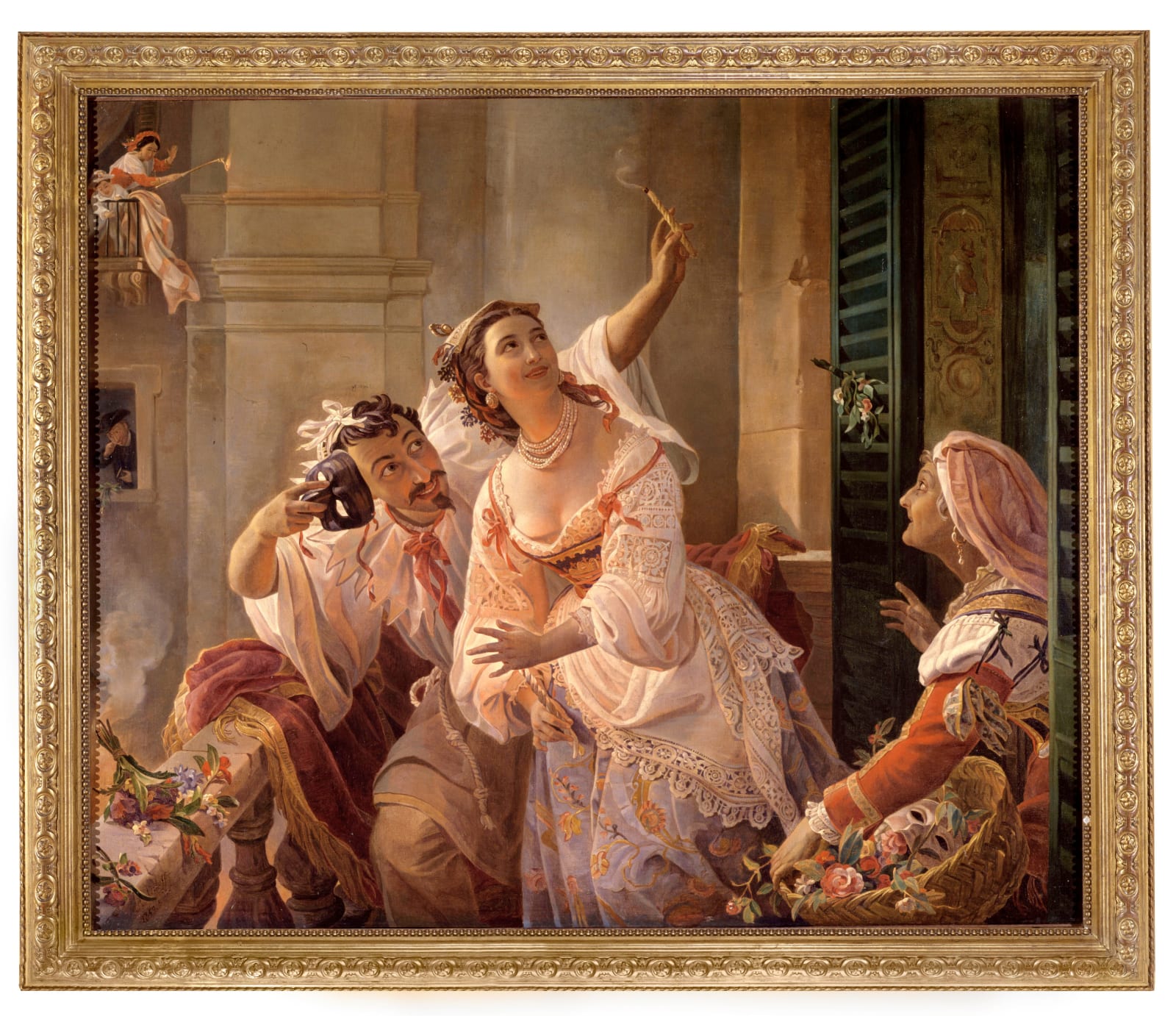Pimen Nikitich ORLOV 1812 -1863
Provenance
Private collection, Rome
Exhibitions
La festa a Roma dal Rinascimento al 1870, Rome, Palazzo Venezia,
23rd May-15th September 1997, cat. n. A/40
Via del Corso: una strada lunga 2000 anni, Roma, Museo del Corso, Palazzo Cipolla,
8th May – 30th September 1999, cat. n. 18
Vedute di Roma, fine XVII- inizio XX secolo, Galleria Paolo Antonacci,
Rome 2000, cat. n.19
Carnevale romano, Roma, Museo di Roma, Palazzo Braschi,
10th February-5th April 2010, cat. n. 67
Another version of this painting, signed in Cyrillic on the bottom left, 93 x 112 cm, can be found at the Russian State Museum in Saint Petersburg (inv. no. 5105)
This feast took place on the evening of "Shrove Tuesday" at the end of the Carnival celebrations. This event had a particular significance for the closed society of papal Rome, as all Roman nobles and not had the opportunity for one evening to mix each other and play together under the masks that guaranteed the anonymity.
At sunset the entire Via del Corso, the street where the event primarily took place, was lit by thousands of candles "moccoletti": the aim of the game was to extinguish each other’s a flame. The penance for those who remained without fire was to take off the mask and reveal the identity.
In our painting while a beautiful maiden is portrayed without a mask, but holding the still burning candle, a young man is painted with the candle already estinguished in the act of taking off his mask. In the corner, an old woman, clearly inspired by a painting of Caravaggio, attends what is happening.
The scene is set in a balcony in front of the church of San Carlo al Corso and the glow and bustle of the street below can be guess beyond the balustrade. The party, much admired by every foreign traveller and artist, was masterfully described by Goethe, Andersen, Gogol and countless other writers.
The feast ended when all candles were extinguished: then began Lent.
Orlov, a portraitist and generalist painter was in Italy since 1841 and worked in Rome, Naples, Palermo.
In 1849 he refuses Zar Nicholas I’s invitation to return to his homeland. He was a member of the Società di Amatori e Cultori di Belle Arti in Rome and participated at the Societys exhibions. At the exhibition of 1856 he exposed a set of portraits.
Still influenced by the romantic atmospheres of his mentor Brjulov, he invents a completely original painting style, as shown in this painting (G. Goldovskij, E. Petrova and C. Poppi, Russian Painting in the Romantic Era (exhibition catalogue, Bologna, Galleria Comunale d’Arte Moderna, 3rd March – 29th April 1990), Bologna, 1990, ad vocem).
This painting dates back to the time when the artist was in his fifties, and about to die. It depicts a scene with an evident sensual background that conveys a ‘romanesque’ idea – playful and at the same time realistic – which inevitably evokes Nicolaj Vasilievic Gogol’s atmospheres, the illustrious Russian writer who spent over ten years of his life in Rome.
Orlov painted another version of this subject signed in cyrillic and dated the same 1859, now in the Russian State Museum in Saint Petersburg, for a Russian client: may be due to the fashionable romantic atmosphere of this event.
This game, ‘The Moccoletti’, was illustrated by many artists, but none of them conveyed the joyful feeling of that characteristic Roman feast as Orlov did.
Orlov, a portraitist and generalist painter was in Italy since 1841 and worked in Rome, Naples, Palermo.
In 1849 he refuses Zar Nicholas I’s invitation to return to his homeland. He was a member of the Società di Amatori e Cultori di Belle Arti in Rome and participated at the Societys exhibions. At the exhibition of 1856 he exposed a set of portraits.
Still influenced by the romantic atmospheres of his mentor Brjulov, he invents a completely original painting style, as shown in this painting (G. Goldovskij, E. Petrova and C. Poppi, Russian Painting in the Romantic Era (exhibition catalogue, Bologna, Galleria Comunale d’Arte Moderna, 3rd March – 29th April 1990), Bologna, 1990, ad vocem).
JOIN OUR MAILING LIST
Subscribe to our mailing list in order to receive news on new acquisitions, exhibitions, special previews and more!
* denotes required fields
We will process the personal data you have supplied to communicate with you in accordance with our Privacy Policy. You can unsubscribe or change your preferences at any time by clicking the link in our emails.



